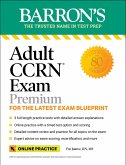Shared Decision Making in Adult Critical Care
Herausgeber: Jaffa, Matthew N; Hwang, David Y
Shared Decision Making in Adult Critical Care
Herausgeber: Jaffa, Matthew N; Hwang, David Y
- Broschiertes Buch
- Merkliste
- Auf die Merkliste
- Bewerten Bewerten
- Teilen
- Produkt teilen
- Produkterinnerung
- Produkterinnerung
An extensive introduction to patient-centeredness in critical care through case-based examples of shared decision making.
Andere Kunden interessierten sich auch für
![Critical Care Examination and Board Review Critical Care Examination and Board Review]() Ronaldo Collo GoCritical Care Examination and Board Review180,99 €
Ronaldo Collo GoCritical Care Examination and Board Review180,99 €![Adult-Gerontology Acute Care Nurse Practitioner Review Book - NP Certification Secrets Study Guide, Full-Length Practice Test, Nursing Review Video Tutorials Adult-Gerontology Acute Care Nurse Practitioner Review Book - NP Certification Secrets Study Guide, Full-Length Practice Test, Nursing Review Video Tutorials]() Matthew BowlingAdult-Gerontology Acute Care Nurse Practitioner Review Book - NP Certification Secrets Study Guide, Full-Length Practice Test, Nursing Review Video Tutorials59,99 €
Matthew BowlingAdult-Gerontology Acute Care Nurse Practitioner Review Book - NP Certification Secrets Study Guide, Full-Length Practice Test, Nursing Review Video Tutorials59,99 €![Medical Decision Making Medical Decision Making]() Alan SchwartzMedical Decision Making101,99 €
Alan SchwartzMedical Decision Making101,99 €![Focused Intensive Care Ultrasound Focused Intensive Care Ultrasound]() Focused Intensive Care Ultrasound160,99 €
Focused Intensive Care Ultrasound160,99 €![Critical Care Emergencies Critical Care Emergencies]() Critical Care Emergencies56,99 €
Critical Care Emergencies56,99 €![Advanced Critical Care Nursing Advanced Critical Care Nursing]() Vicki S GoodAdvanced Critical Care Nursing153,99 €
Vicki S GoodAdvanced Critical Care Nursing153,99 €![Adult Ccrn Exam Premium: Study Guide for the Latest Exam Blueprint, Includes 3 Practice Tests, Comprehensive Review, and Online Study Prep Adult Ccrn Exam Premium: Study Guide for the Latest Exam Blueprint, Includes 3 Practice Tests, Comprehensive Review, and Online Study Prep]() Barron's Educational SeriesAdult Ccrn Exam Premium: Study Guide for the Latest Exam Blueprint, Includes 3 Practice Tests, Comprehensive Review, and Online Study Prep43,99 €
Barron's Educational SeriesAdult Ccrn Exam Premium: Study Guide for the Latest Exam Blueprint, Includes 3 Practice Tests, Comprehensive Review, and Online Study Prep43,99 €-
-
-
An extensive introduction to patient-centeredness in critical care through case-based examples of shared decision making.
Hinweis: Dieser Artikel kann nur an eine deutsche Lieferadresse ausgeliefert werden.
Hinweis: Dieser Artikel kann nur an eine deutsche Lieferadresse ausgeliefert werden.
Produktdetails
- Produktdetails
- Verlag: Cambridge University Press
- Seitenzahl: 208
- Erscheinungstermin: 5. August 2021
- Englisch
- Abmessung: 185mm x 196mm x 10mm
- Gewicht: 227g
- ISBN-13: 9781108735544
- ISBN-10: 1108735541
- Artikelnr.: 61210503
- Herstellerkennzeichnung
- Libri GmbH
- Europaallee 1
- 36244 Bad Hersfeld
- gpsr@libri.de
- Verlag: Cambridge University Press
- Seitenzahl: 208
- Erscheinungstermin: 5. August 2021
- Englisch
- Abmessung: 185mm x 196mm x 10mm
- Gewicht: 227g
- ISBN-13: 9781108735544
- ISBN-10: 1108735541
- Artikelnr.: 61210503
- Herstellerkennzeichnung
- Libri GmbH
- Europaallee 1
- 36244 Bad Hersfeld
- gpsr@libri.de
Preface; 1. When does shared decision making apply in adult critical care?
Matthew Jaffa and David Hwang; 2. How much does the family want to be
involved in decision making? Christopher Bryant and Michael Rubin; 3. Show
me the data: Tips for discussing numerical risk in critical care Mitra
Haeri and Melissa Motta; 4. Communication skills for critical care family
meetings Jessica Macfarlin; 5. The do-not-resuscitate order Timothy M.
Dempsey and Michael E. Wilson; 6. The do-not-intubate order Catherine
Auriemma and Joshua Kayser; 7. Prolonged ventilator dependence for the
pulmonary patient Matthew Wilson and Phil Choi; 8. Renal replacement
therapy Hassan Suleiman and Paul McCarthy; 9. Shared decision making during
extracorporeal membrane oxygenation Barnaby Lewin and Kollengode
Ramanathan; 10. Hypoxic-Ischemic brain injury following cardiac arrest
Sonya Zhou and Carolina Maciel; 11. Decompressive craniectomy for stroke
patients Matthew Jaffa (U Maryland) and David Hwang (Yale); 12.
Decompressive craniectomy for traumatic brain injury patients Connie Ge,
Angelos Kolias and Susanne Muehlschlegel; 13. Severe traumatic spinal cord
injury Christopher Marcellino (Mayo) and Alejandro Rabinstein (Mayo); 14.
Potentially inappropriate treatment and conscientious objections Nneka
Sederstrom and Alexandra Wichmann; 15. Shared decision making in emergent
situations Katharine R. Colton and Evie G. Marcolini; 16. Advance
directives: Policy, law, and use in shared decision making Josh Rolnick;
17. Care of the unbefriended patient Stephen Trevick; 18. The role of
palliative care in the intensive care unit Adeline Goss and Claire
Creutzfeldt; 19. Measuring and evaluating shared decision making in the
intensive care unit Alison Turnbull and Jacquline Kruser; 20. Brain death
discussions Elizabeth Carroll and Ariane Lewis.
Matthew Jaffa and David Hwang; 2. How much does the family want to be
involved in decision making? Christopher Bryant and Michael Rubin; 3. Show
me the data: Tips for discussing numerical risk in critical care Mitra
Haeri and Melissa Motta; 4. Communication skills for critical care family
meetings Jessica Macfarlin; 5. The do-not-resuscitate order Timothy M.
Dempsey and Michael E. Wilson; 6. The do-not-intubate order Catherine
Auriemma and Joshua Kayser; 7. Prolonged ventilator dependence for the
pulmonary patient Matthew Wilson and Phil Choi; 8. Renal replacement
therapy Hassan Suleiman and Paul McCarthy; 9. Shared decision making during
extracorporeal membrane oxygenation Barnaby Lewin and Kollengode
Ramanathan; 10. Hypoxic-Ischemic brain injury following cardiac arrest
Sonya Zhou and Carolina Maciel; 11. Decompressive craniectomy for stroke
patients Matthew Jaffa (U Maryland) and David Hwang (Yale); 12.
Decompressive craniectomy for traumatic brain injury patients Connie Ge,
Angelos Kolias and Susanne Muehlschlegel; 13. Severe traumatic spinal cord
injury Christopher Marcellino (Mayo) and Alejandro Rabinstein (Mayo); 14.
Potentially inappropriate treatment and conscientious objections Nneka
Sederstrom and Alexandra Wichmann; 15. Shared decision making in emergent
situations Katharine R. Colton and Evie G. Marcolini; 16. Advance
directives: Policy, law, and use in shared decision making Josh Rolnick;
17. Care of the unbefriended patient Stephen Trevick; 18. The role of
palliative care in the intensive care unit Adeline Goss and Claire
Creutzfeldt; 19. Measuring and evaluating shared decision making in the
intensive care unit Alison Turnbull and Jacquline Kruser; 20. Brain death
discussions Elizabeth Carroll and Ariane Lewis.
Preface; 1. When does shared decision making apply in adult critical care?
Matthew Jaffa and David Hwang; 2. How much does the family want to be
involved in decision making? Christopher Bryant and Michael Rubin; 3. Show
me the data: Tips for discussing numerical risk in critical care Mitra
Haeri and Melissa Motta; 4. Communication skills for critical care family
meetings Jessica Macfarlin; 5. The do-not-resuscitate order Timothy M.
Dempsey and Michael E. Wilson; 6. The do-not-intubate order Catherine
Auriemma and Joshua Kayser; 7. Prolonged ventilator dependence for the
pulmonary patient Matthew Wilson and Phil Choi; 8. Renal replacement
therapy Hassan Suleiman and Paul McCarthy; 9. Shared decision making during
extracorporeal membrane oxygenation Barnaby Lewin and Kollengode
Ramanathan; 10. Hypoxic-Ischemic brain injury following cardiac arrest
Sonya Zhou and Carolina Maciel; 11. Decompressive craniectomy for stroke
patients Matthew Jaffa (U Maryland) and David Hwang (Yale); 12.
Decompressive craniectomy for traumatic brain injury patients Connie Ge,
Angelos Kolias and Susanne Muehlschlegel; 13. Severe traumatic spinal cord
injury Christopher Marcellino (Mayo) and Alejandro Rabinstein (Mayo); 14.
Potentially inappropriate treatment and conscientious objections Nneka
Sederstrom and Alexandra Wichmann; 15. Shared decision making in emergent
situations Katharine R. Colton and Evie G. Marcolini; 16. Advance
directives: Policy, law, and use in shared decision making Josh Rolnick;
17. Care of the unbefriended patient Stephen Trevick; 18. The role of
palliative care in the intensive care unit Adeline Goss and Claire
Creutzfeldt; 19. Measuring and evaluating shared decision making in the
intensive care unit Alison Turnbull and Jacquline Kruser; 20. Brain death
discussions Elizabeth Carroll and Ariane Lewis.
Matthew Jaffa and David Hwang; 2. How much does the family want to be
involved in decision making? Christopher Bryant and Michael Rubin; 3. Show
me the data: Tips for discussing numerical risk in critical care Mitra
Haeri and Melissa Motta; 4. Communication skills for critical care family
meetings Jessica Macfarlin; 5. The do-not-resuscitate order Timothy M.
Dempsey and Michael E. Wilson; 6. The do-not-intubate order Catherine
Auriemma and Joshua Kayser; 7. Prolonged ventilator dependence for the
pulmonary patient Matthew Wilson and Phil Choi; 8. Renal replacement
therapy Hassan Suleiman and Paul McCarthy; 9. Shared decision making during
extracorporeal membrane oxygenation Barnaby Lewin and Kollengode
Ramanathan; 10. Hypoxic-Ischemic brain injury following cardiac arrest
Sonya Zhou and Carolina Maciel; 11. Decompressive craniectomy for stroke
patients Matthew Jaffa (U Maryland) and David Hwang (Yale); 12.
Decompressive craniectomy for traumatic brain injury patients Connie Ge,
Angelos Kolias and Susanne Muehlschlegel; 13. Severe traumatic spinal cord
injury Christopher Marcellino (Mayo) and Alejandro Rabinstein (Mayo); 14.
Potentially inappropriate treatment and conscientious objections Nneka
Sederstrom and Alexandra Wichmann; 15. Shared decision making in emergent
situations Katharine R. Colton and Evie G. Marcolini; 16. Advance
directives: Policy, law, and use in shared decision making Josh Rolnick;
17. Care of the unbefriended patient Stephen Trevick; 18. The role of
palliative care in the intensive care unit Adeline Goss and Claire
Creutzfeldt; 19. Measuring and evaluating shared decision making in the
intensive care unit Alison Turnbull and Jacquline Kruser; 20. Brain death
discussions Elizabeth Carroll and Ariane Lewis.








